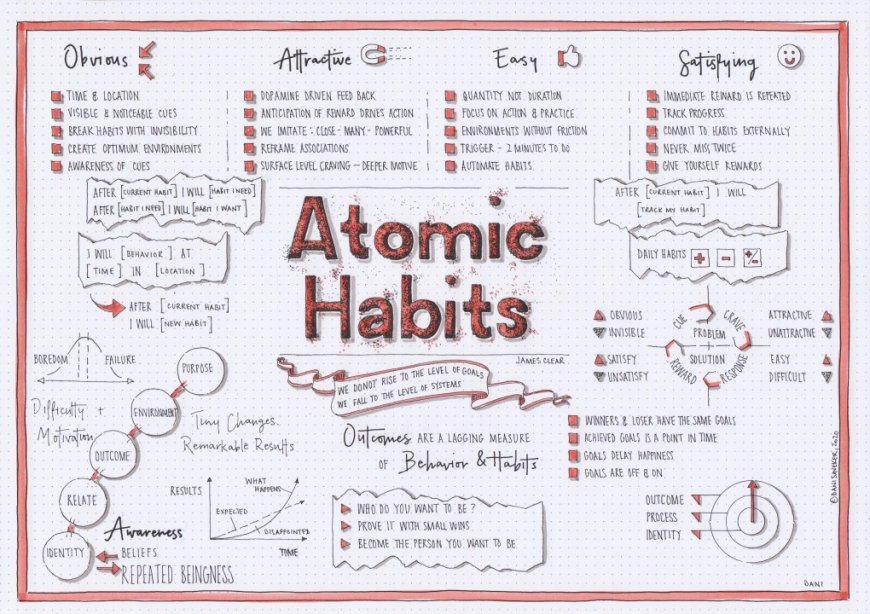Atomic Habits in Action: Small Shifts That Lead to Life-Changing Results
Discover how tiny, consistent changes can lead to life-changing success. Learn how to apply Atomic Habits in real life for massive results.

Atomic Habits in Action: Tiny Changes That Create Massive Results
In a world obsessed with overnight success, it’s easy to overlook the power of small, consistent actions. Atomic Habits, a groundbreaking book by James Clear, revolutionized the way we think about habits by proving that minor improvements, repeated over time, lead to extraordinary results. But how does this work in real life? Let’s break down how atomic habits can transform your productivity, health, and mindset—one tiny step at a time.
The Power of 1% Improvement
Imagine improving just 1% every day. It may seem insignificant at first, but over a year, that tiny improvement compounds to nearly a 37x increase in performance. This principle, known as the aggregation of marginal gains, is what separates high achievers from the rest.
Take the British cycling team, for example. Under coach Dave Brailsford, they focused on micro-improvements—adjusting bike seats, redesigning helmets, improving sleep patterns. Within a decade, they dominated world cycling, winning multiple Olympic gold medals and Tour de France titles.
Lesson: Small changes, applied consistently, can lead to astonishing success.
Four Laws of Atomic Habits (and How to Apply Them)
James Clear breaks habit formation into four laws. Let’s see them in action:
1. Make It Obvious: Design Your Environment
Your environment dictates your habits. Want to drink more water? Keep a water bottle on your desk. Trying to read more? Place a book on your pillow.
? Real-Life Example: Tech mogul Bill Gates reads 50 books a year. His secret? A bedside stack of books, making reading an obvious and convenient habit.
2. Make It Attractive: Link Habits to Rewards
We’re more likely to stick to habits if they feel rewarding. This is where habit stacking comes in—pairing a new habit with an existing one.
? Example: Love coffee? Use your morning coffee time to review your goals or listen to a podcast. By associating a new habit with a pleasurable activity, it becomes more desirable.
3. Make It Easy: Reduce Friction
The easier a habit is, the more likely you are to stick with it. Start small—if you want to work out, commit to just five push-ups a day. If you want to write, start with one sentence.
? Example: Bestselling author Stephen King writes 2,000 words daily. His trick? A dedicated writing space and a strict morning routine.
4. Make It Satisfying: Track Your Progress
What gets measured gets improved. Habit tracking keeps you motivated by showing progress, no matter how small.
? Example: Jerry Seinfeld used a “Don’t Break the Chain” technique—marking an ‘X’ on a calendar every time he wrote a joke. The goal? Never break the chain.
Breaking Bad Habits: The Inversion of the Four Laws
Just as we can build good habits, we can break bad ones by reversing the four laws:
✅ Make it invisible (remove triggers)
✅ Make it unattractive (highlight the downsides)
✅ Make it difficult (add friction)
✅ Make it unsatisfying (introduce accountability)
Example: Want to stop snacking? Keep junk food out of sight. Want to reduce phone use? Leave your phone in another room while working.
Why Atomic Habits Work in the Real World
Many successful people unknowingly apply these principles:
- Elon Musk: Uses first-principles thinking to break down big goals into small, achievable steps.
- Warren Buffett: Reads daily, a habit that compounds knowledge over time.
- Oprah Winfrey: Stresses consistency in self-improvement routines like gratitude journaling.
Final Thoughts: Start Small, Think Big
Success isn’t about radical change—it’s about tiny, consistent improvements. Whether you’re looking to build wealth, improve health, or boost productivity, atomic habits provide a science-backed framework to get there.
Start today—pick one small habit and commit to it. Over time, those tiny actions will snowball into massive success.
Also read:
- James Clear’s Official Website – Deep dive into his research on habits.
- Harvard Business Review: The Science of Building Better Habits – Insights into habit-building for professionals.
- National Library of Medicine Study on Habit Formation – Scientific perspective on habit psychology.
What's Your Reaction?
 Like
0
Like
0
 Dislike
0
Dislike
0
 Love
0
Love
0
 Funny
0
Funny
0
 Angry
0
Angry
0
 Sad
0
Sad
0
 Wow
0
Wow
0



















































